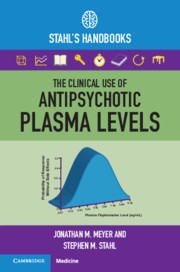Book contents
- The Clinical Use of Antipsychotic Plasma Levels
- Reviews
- The Clinical Use of Antipsychotic Plasma Levels
- Copyright page
- Half title page
- Contents
- Foreword
- Preface: How to Use This Handbook and Useful Tables for Handy Reference
- Introduction
- 1 Sampling Times for Oral and Long-Acting Injectable Agents
- 2 The Therapeutic Threshold and the Point of Futility
- 3 Level Interpretation Including Laboratory Reporting Issues, Responding to High Plasma Levels, Special Situations (Hepatic Dysfunction, Renal Dysfunction and Hemodialysis, Bariatric Surgery)
- 4 Tracking Oral Antipsychotic Adherence
- 5 What Is an Adequate Antipsychotic Trial? Using Plasma Levels to Optimize Psychiatric Response and Tolerability
- 6 Important Concepts about First-Generation Antipsychotics
- 7 Haloperidol and Haloperidol Decanoate
- 8 Fluphenazine and Fluphenazine Decanoate
- 9 Perphenazine and Perphenazine Decanoate
- 10 Zuclopenthixol and Zuclopenthixol Decanoate; Flupenthixol and Flupenthixol Decanoate
- 11 Chlorpromazine, Loxapine, Thiothixene, Trifluoperazine
- 12 Important Concepts about Second-Generation Antipsychotics
- 13 Clozapine
- 14 Risperidone Oral and Long-Acting Injectable; Paliperidone Oral and Long-Acting Injectable
- 15 Olanzapine and Olanzapine Pamoate
- 16 Aripiprazole, Aripiprazole Monohydrate, and Aripiprazole Lauroxil
- 17 Amisulpride, Asenapine, Lurasidone, Brexpiprazole, Cariprazine
- Appendix Therapeutic Threshold, Point of Futility, AGNP/ASCP Laboratory Alert Level, and Average Oral Concentration–Dose Relationships
- Index
- References
14 - Risperidone Oral and Long-Acting Injectable; Paliperidone Oral and Long-Acting Injectable
Published online by Cambridge University Press: 19 October 2021
- The Clinical Use of Antipsychotic Plasma Levels
- Reviews
- The Clinical Use of Antipsychotic Plasma Levels
- Copyright page
- Half title page
- Contents
- Foreword
- Preface: How to Use This Handbook and Useful Tables for Handy Reference
- Introduction
- 1 Sampling Times for Oral and Long-Acting Injectable Agents
- 2 The Therapeutic Threshold and the Point of Futility
- 3 Level Interpretation Including Laboratory Reporting Issues, Responding to High Plasma Levels, Special Situations (Hepatic Dysfunction, Renal Dysfunction and Hemodialysis, Bariatric Surgery)
- 4 Tracking Oral Antipsychotic Adherence
- 5 What Is an Adequate Antipsychotic Trial? Using Plasma Levels to Optimize Psychiatric Response and Tolerability
- 6 Important Concepts about First-Generation Antipsychotics
- 7 Haloperidol and Haloperidol Decanoate
- 8 Fluphenazine and Fluphenazine Decanoate
- 9 Perphenazine and Perphenazine Decanoate
- 10 Zuclopenthixol and Zuclopenthixol Decanoate; Flupenthixol and Flupenthixol Decanoate
- 11 Chlorpromazine, Loxapine, Thiothixene, Trifluoperazine
- 12 Important Concepts about Second-Generation Antipsychotics
- 13 Clozapine
- 14 Risperidone Oral and Long-Acting Injectable; Paliperidone Oral and Long-Acting Injectable
- 15 Olanzapine and Olanzapine Pamoate
- 16 Aripiprazole, Aripiprazole Monohydrate, and Aripiprazole Lauroxil
- 17 Amisulpride, Asenapine, Lurasidone, Brexpiprazole, Cariprazine
- Appendix Therapeutic Threshold, Point of Futility, AGNP/ASCP Laboratory Alert Level, and Average Oral Concentration–Dose Relationships
- Index
- References
Summary
Zotepine was approved in Japan in 1982, and is the first antipsychotic modeled on clozapine with relatively high serotonin 5HT2A affinity, lower dopamine D2 affinity, and a corresponding Positron Emission Tomography (PET) imaging profile that demonstrates wide separation between the 5HT2A and D2 occupancy curves in a manner unlike first-generation antipsychotics (FGAs) such as loxapine (see Chapter 11) [12–14]. Zotepine was never approved in the United States (US), Canada, the United Kingdom, Australia, or most European countries, leaving risperidone (US approval December 29, 1993) as the first commercially successful second-generation antipsychotic [15].
- Type
- Chapter
- Information
- The Clinical Use of Antipsychotic Plasma LevelsStahl's Handbooks, pp. 267 - 295Publisher: Cambridge University PressPrint publication year: 2021



